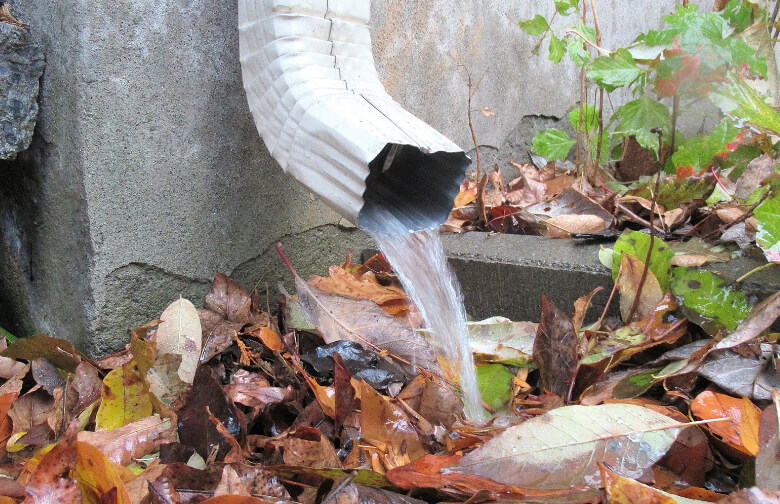Protecting Your Home Against Rainwater Damage
Contents
Rainfall may be a sound to sleep to, but it can also cause damage to a home’s foundation if it isn’t managed correctly. Clogged gutters are just the beginning – water needs to be moved away from the house so that it doesn’t erode the soil or collect near the foundation. To address this problem, many homeowners choose to install an underground gutter drainage system, such as a French drain.
Gutters and underground drains are essential components of a home’s rainwater system. By diverting water away from your foundation, they can help prevent serious damage and keep your basement dry. But how do you know if you need to have your underground drains cleaned? Read on to learn more about the signs you need underground gutter drains, as well as why they are important and what the ideal situation looks like for protecting your home.
Why do some downspouts go into the ground?
Have you ever wondered why some homes have downspouts that lead into the ground? It may seem strange, but the answer is actually quite simple.
Downspouts are a critical part of a home’s gutter system. Their job is to direct rainwater away from a home’s foundation and towards an area where it can safely disperse. In some cases, this means leading the water into a nearby storm drain or dry well. But in other cases, like those with a particularly sandy or clay-rich soil composition, homeowners may choose to have their downspouts go directly into the ground.
This helps to prevent pooling around a home’s foundation, which can cause structural damage if left unchecked. The sand and clay will slowly absorb the water, helping to keep it away from the house and preventing it from seeping into basements and crawl spaces. In addition, this is a great way to maintain moisture levels in the soil around the home, which keeps plants healthy and ensures lush landscaping.
Installing an underground downspout drain is especially beneficial for homeowners who live in areas with sandy or clay-rich soils. This method of rainwater dispersal helps to preserve the structural integrity of your home while also providing a great way to keep landscaping looking its best.
What’s an Underground Downspout Drain?
An underground downspout drain is a pipe connected to the gutters of your roof. Its purpose is to carry rainwater away from your house, which helps protect the inside and outside of your home from water damage.
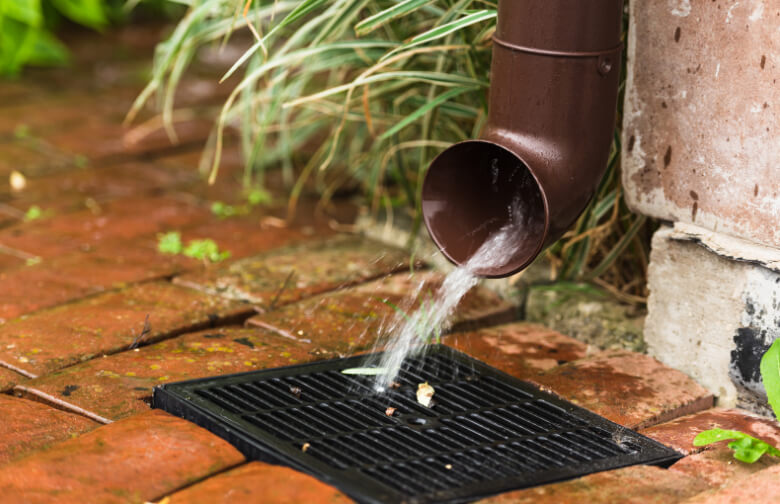
Installing a buried downspout system is an effective and low-maintenance way to protect your home’s foundation and basement from damaging moisture. By routing the water away from the house, homeowners can prevent costly damage to their property.
Where is the Drain Located?
Downspouts are located near a corner of a house, where they run down the side at the steepest angle for proper water runoff. From there, these pipes lead to an underground drainage system. Maintaining proper runoff will also prevent the build-up of moss or mildew on your roof or exterior walls.
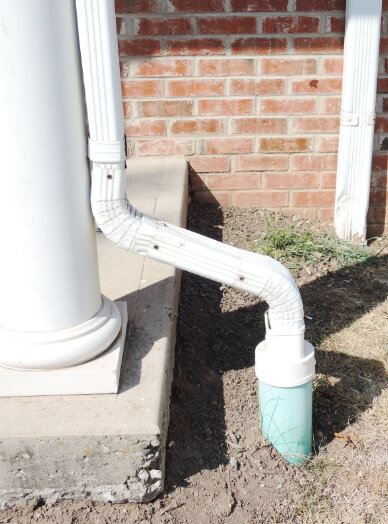
When designing your drainage system, it is essential to use WYE fittings for optimal performance. These fittings ensure the lines follow the natural flow of water, dramatically improving the efficiency of your system. To protect the lines from clogging due to shingle gravel, an inline catch basin should be installed near the roof.
Where possible, 3 in. corrugated pipe should be used as it takes up less area than 4 in. pipes while still providing adequate drainage. A downspout cleanout can be utilized when venting the downspout at the house. This cleanout option makes accessing your line much easier, allowing you to run cameras or heat cables through the system with ease.
Signs You Need Underground Gutter Drains
If you’re experiencing flooded basements and garages, along with foundation and wood damage, it may be time to consider underground gutter drains. Rain gutters that drop water within the footprint of your home direct water toward your foundation, and we can identify areas of risk during their assessment. Other signs include pooling in your yard near where the underground drain is installed or rainwater overflowing even after cleaning.
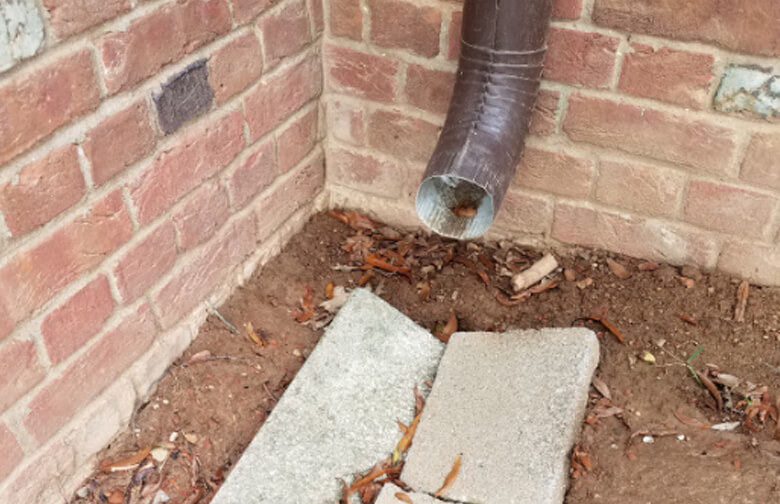
Why Underground Downspout Drains?
Without extensions or underground drains, all the rainwater from your roof will end up pooling at the base of your home. Over time, this water can penetrate your foundation, undermine stairs and patios, and cause other significant damage. The right solution — such as fixing broken gutters, installing underground drains, or preventing rainwater overflow — should be tailored to your specific situation. Additionally, gutters draining into high-traffic areas create a slipping hazard; running them through underground drainage pipes ensures they stay away from walkways and driveways.
French Drain
Installing an underground gutter drainage system is a great way to protect your home from potential water damage. It may take some time and effort to do, but you’ll have peace of mind knowing that your foundation is safe and secure against the elements.
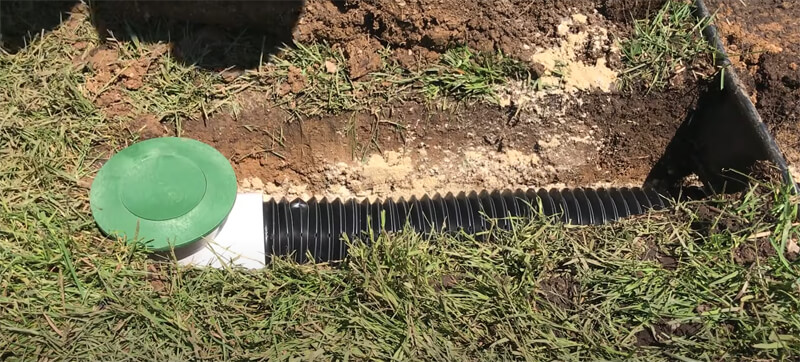
A French drain can be an effective long-term solution because it prevents debris from clogging up the pipe. Installing one is relatively easy and affordable. The cost of materials for a 9″ catch basin and 10ft distance should only be around $105 when doing the work yourself.
However, french drains are prone to clogging. When this happens, water is unable to drain properly from the gutter, resulting in overflow and potential damage. Clogs can be partial, allowing some water to pass, or complete, preventing all water flow. Therefore, it is important to inspect your underground drains on a regular basis to ensure they remain free of debris.
Choosing a Good Underground Drain
Downspouts come in different materials such as galvanized steel, stainless steel, aluminum, PVC, plastic, and copper. It’s important that the material you use for the underground portion gets approval from plumbing codes and is strong and long-lasting. Common materials for this part include clay, PVC, or perforated plastic pipes.
Going the DIY Route
Installing an underground downspout drain yourself can save money. If you’re up for this project, make sure to choose the correct size, install enough downspouts to fit the needs of your gutter system (typically one every 20 feet), and position them close to corners. Also, don’t forget to adhere to all safety protocols.
Finding a Break in the Grade
When laying out where to run your underground downspout system, take it as far away from the house as necessary until you reach a break in the grade. This drop in elevation will ensure that the excess water is shed away from the house and not pooled around it.
Leaching Excess Water
By building your gutter downspout line so that any remaining water is leached into the subsoil, you can stop mosquito breeding and pungent odors. In colder temperatures, you bypass the problem of having a frozen block of ice at the end of the pipe and prevent any damming of melting snow.
To achieve this effect, install a piece of knife-cut pipe with some sock fabric on the end and build a mini dry well around it. Then, fill the dry well with drainage stones and cover it with native soil. The sock fabric ensures that the remaining water in the line will be able to soak away, allowing it to leach harmlessly into the subsoil.
The Ideal Situation
When it comes to protecting your home against rainwater-related damage, having new or working gutters, mesh gutter guards, and underground drainage pipe is the best combination. This prevents clogs in your underground drains which would require expensive cleanings, and it helps divert the water far away from your home. These three elements are essential for protecting your house from long-term damage.

